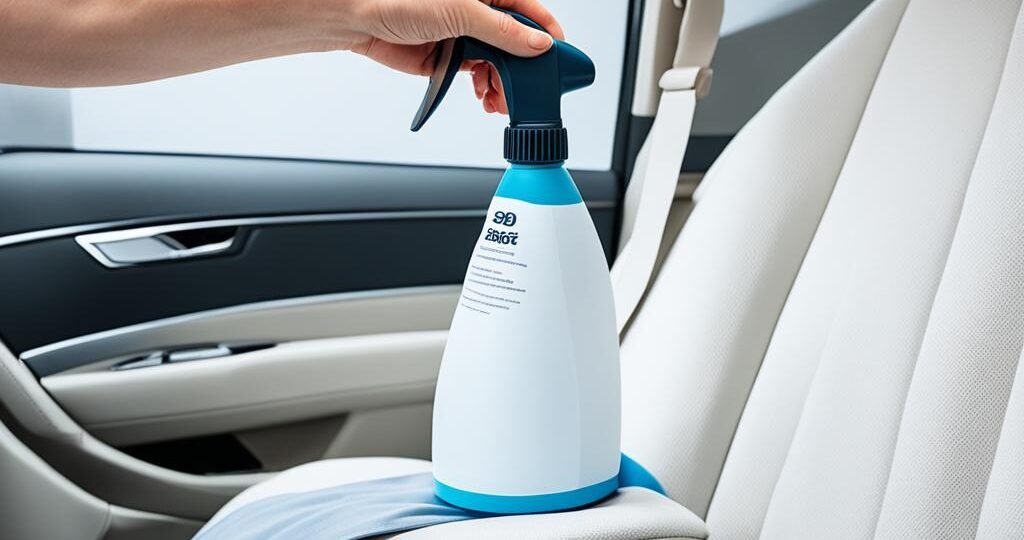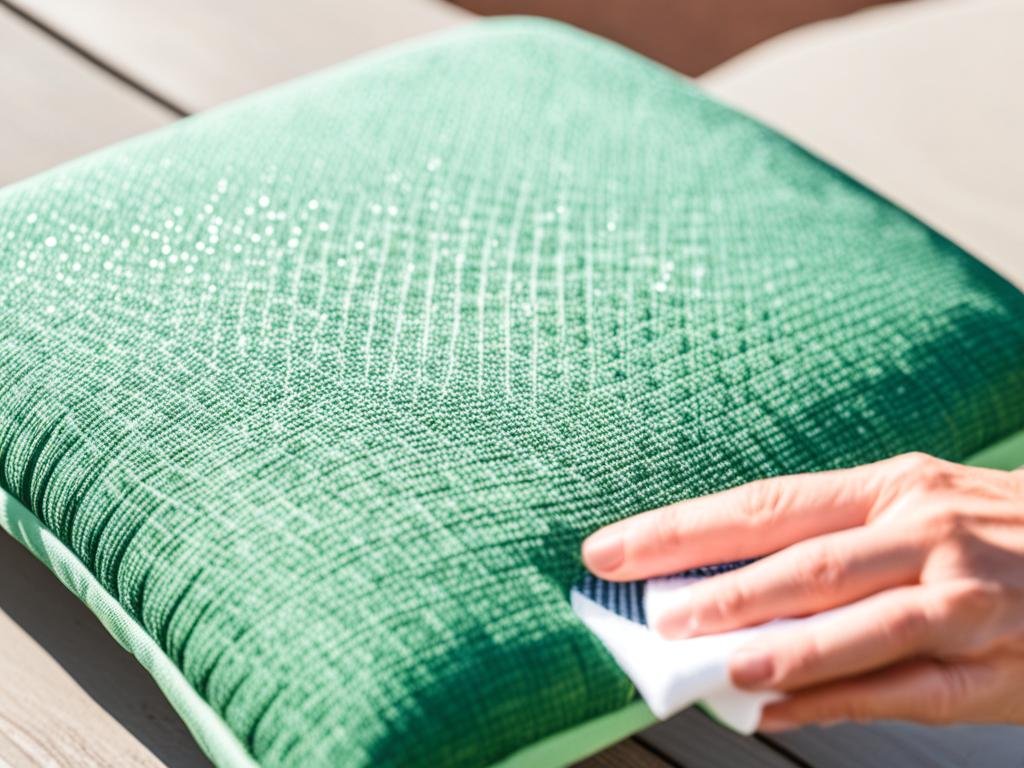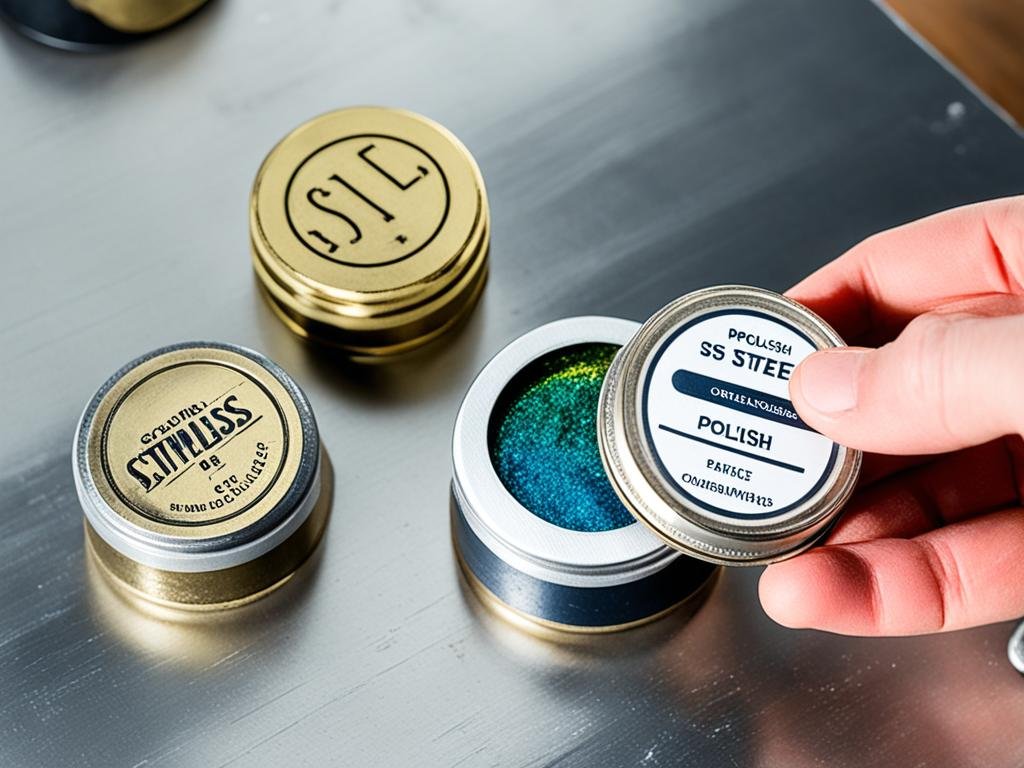
Our carefully curated selection not only promises exceptional results but also elevates your detailing experience. Dive into our top choices and see the difference quality makes in preserving and enhancing your vehicle’s beauty.
Key Takeaways:
- Follow the application instructions for 303 Fabric Guard to ensure effective and long-lasting results.
- Regular maintenance with Fabric Guard can extend the life of outdoor fabrics and protect against stains and mildew.
- Thoroughly clean and dry the fabric before applying Fabric Guard.
- Apply Fabric Guard evenly and allow it to dry completely before use.
- The frequency of reapplication depends on factors such as sunlight exposure and frequency of use.
The Importance of Fabric Maintenance
Outdoor fabric maintenance is crucial for preserving the water repellency, durability, and overall appearance of your outdoor fabrics. Whether it’s the fabric used on your patio furniture, boat cushions, or RV awnings, regular maintenance is essential to protect against stains, mildew, and the harmful effects of the elements.
One of the key factors in outdoor fabric maintenance is maintaining the fabric’s water repellency. Over time, the water repellent coating on outdoor fabrics naturally diminishes, leaving them more vulnerable to water damage. Regular cleaning and re-treatment with a fabric protector, such as the 303 Fabric Guard, can help restore and enhance the fabric’s water repellency.
The benefits of maintaining your outdoor fabrics go beyond water repellency. Proper fabric protection also helps to prevent staining, fading, and the growth of mildew. By regularly cleaning and re-treating your fabrics, you not only extend their lifespan but also keep them looking their best, even after prolonged exposure to the sun, rain, and other outdoor elements.
“Outdoor fabrics require regular maintenance to maintain their water repellency and protect against stains and mildew.”
303 Fabric Guard: The Ultimate Fabric Protection
When it comes to fabric protection, one of the most trusted products in the market is 303 Fabric Guard. This powerful fabric treatment is specifically formulated to provide long-lasting protection against stains, water damage, and UV rays. It helps to maintain the fabric’s water repellency, ensuring that water beads up and rolls off instead of being absorbed.
303 Fabric Guard is easy to apply and suitable for use on a wide range of outdoor fabrics, including solution-dyed acrylic, polyester, nylon, cotton, silk, wool, and fine leathers like suede. It creates an invisible barrier that repels liquids and prevents stains from setting into the fabric.
By regularly cleaning and re-treating your outdoor fabrics with 303 Fabric Guard, you can enjoy the following benefits:
- Enhanced water repellency
- Protection against stains
- Prevention of fading and discoloration
- Reduced risk of mildew formation
- Extended lifespan of outdoor fabrics

| Benefits | Solution |
|---|---|
| Water repellency | 303 Fabric Guard restores and maintains the water repellency of outdoor fabrics, ensuring they stay dry and resistant to water damage. |
| Stain prevention | 303 Fabric Guard forms an invisible barrier that repels liquids and prevents stains from setting into the fabric, making it easier to clean and maintain. |
| UV protection | 303 Fabric Guard offers UV resistance, protecting outdoor fabrics from fading and discoloration caused by prolonged sun exposure. |
| Mildew resistance | 303 Fabric Guard helps to prevent the growth of mildew by creating a protective barrier that inhibits its formation on outdoor fabrics. |
| Long-lasting performance | 303 Fabric Guard provides durable protection, maintaining the integrity of outdoor fabrics and extending their lifespan. |
Preparing the Fabric for Application
Before applying 303 Fabric Guard, proper fabric preparation is key to ensuring optimal results and long-lasting protection. Follow these steps to clean and assess your fabric before treatment.
Cleaning the Fabric
To begin, thoroughly clean the fabric to remove any dirt, debris, or stains. This is crucial for allowing the Fabric Guard to adhere effectively. Use a suitable fabric cleaner, such as those offered by Rosie Dazzler, to target specific stains and ensure a thorough clean.
“We recommend using Rosie Dazzler’s fabric cleaner specifically formulated for the type of fabric you are treating. Their products are designed to effectively remove stains without leaving any residue, ensuring a clean surface for the application of 303 Fabric Guard.”
Carefully follow the instructions provided on the fabric cleaner’s packaging, ensuring you apply it evenly and thoroughly. Once the cleaner is applied, gently agitate the fabric using a soft brush or cloth to lift away any dirt or stains. Remember to pay extra attention to heavily soiled areas.
After scrubbing, rinse the fabric with clean water to remove the cleaner and any remaining residue. Thorough rinsing is essential to prevent any chemical interactions with the Fabric Guard that may compromise its effectiveness.
Colorfastness Test
Before applying 303 Fabric Guard to the entire fabric, it’s essential to perform a colorfastness test on a small, inconspicuous area. This will help you determine if the fabric is suitable for treatment, as well as identify any potential color bleeding or fading.
To conduct the colorfastness test, follow these steps:
- Choose a hidden or inconspicuous area of the fabric, such as a seam or hem.
- Apply a small amount of 303 Fabric Guard to the test area.
- Gently rub the fabric with a white cloth to see if any color transfers.
If no color transfers onto the cloth, the fabric is colorfast and can proceed with the application of 303 Fabric Guard. However, if you notice any color bleeding or fading, it is best to consult a professional or refrain from treating the fabric to avoid potential damage.
Thorough Drying
After cleaning and performing the colorfastness test, allow the fabric to dry completely before applying 303 Fabric Guard. Damp or wet fabric can hinder the effectiveness of the treatment and may result in uneven coverage or product wastage.
Ensure proper fabric drying by following these steps:
- Hang the fabric in a well-ventilated area or lay it flat on a clean surface.
- Avoid exposing the fabric to direct sunlight during the drying process, as this can cause color fading or distortion.
- Allow sufficient time for the fabric to air dry completely. This may vary depending on the fabric type and environmental conditions.
Once the fabric is thoroughly dry, it is ready for the application of 303 Fabric Guard.
| Fabric Preparation Checklist |
|---|
| Clean the fabric using Rosie Dazzler’s fabric cleaner |
| Rinse the fabric thoroughly to remove any cleaning residue |
| Perform a colorfastness test in an inconspicuous area |
| Ensure the fabric is completely dry before applying 303 Fabric Guard |
Applying 303 Fabric Guard
When it comes to the application of 303 Fabric Guard, there are a few key factors to consider to ensure optimal results. Follow these guidelines to achieve effective protection and prolong the life of your outdoor fabrics.
Spray Application for Even Coverage
Start by selecting a warm day with full sun for the application process. This creates favorable conditions for the fabric to absorb the protective formula. Additionally, ensure the temperature is above 70°F for the best results.
To achieve even coverage, hold the spray bottle approximately 6-8 inches away from the fabric surface. Spray in a smooth, sweeping motion, making sure to cover the entire surface. Be sure to overlap the sprayed areas to ensure no spots are missed.
Drying Time and Protection from Overspray
Once the fabric has been evenly sprayed, allow it to dry completely before use. This ensures that the protective coating has properly bonded with the fabric fibers. The drying time can vary depending on the temperature, ranging from 6-12 hours. To avoid any accidental overspray, cover or protect any adjacent surfaces that should not come into contact with the Fabric Guard solution.
Recommended Temperature for Application
It is important to apply 303 Fabric Guard in temperatures above 70°F. The warmer the temperature, the better the absorption and bonding of the protective formula to the fabric. This helps to enhance the durability of the fabric and prolong the effectiveness of the water repellent coating.
By following these application techniques, you can ensure optimal protection for your outdoor fabrics. The spray application, even coverage, appropriate drying time, and protection from overspray are essential steps in maintaining the longevity and water repellency of your outdoor fabrics.
Frequency of Reapplication
Regular reapplication of fabric protection is crucial to maintain its water repellency and overall performance. The frequency of reapplication depends on several factors that can affect the durability of the coating.
Fabric Cleaning Frequency
Regularly cleaning your fabric is essential to extend the lifespan of the protective coating. We recommend cleaning the fabric once a month using plain water to remove any dirt or debris. This simple maintenance routine can help preserve the cleanliness of the fabric and reduce the need for frequent reapplication.
Factors Affecting Reapplication
Several factors can influence the need for reapplying fabric protection. The fabric’s exposure to sunlight, weather conditions (especially heavy rain or snow), and frequency of use all contribute to the gradual breakdown of the protective coating. If your fabric is exposed to harsh outdoor elements or experiences frequent use, you may need to reapply the fabric protection more frequently to ensure continued water repellency.
Testing Fabric Water Repellency
Regularly testing the water repellency of your fabric is a simple way to determine if it requires reapplication. Lightly misting the fabric with water every few months can help assess its performance. If the water beads up and runs off the fabric’s surface, it indicates that the protective coating is still effective. However, if the water no longer repels and starts to absorb into the fabric, it may be time to reapply the fabric protection.
By considering these factors and implementing a regular cleaning routine, you can help maintain the water repellency of your fabric and ensure long-lasting protection against the elements.
Suitable Fabrics for 303 Fabric Guard
303 Fabric Guard is a versatile product that can be safely used on a wide range of natural and synthetic textiles. Whether you have solution-dyed acrylic, polyester, nylon, cotton, silk, wool, or fine leathers like suede, 303 Fabric Guard is designed to provide excellent protection and preserve the quality of your fabrics.
By applying 303 Fabric Guard, you can enhance the water repellency and durability of these materials, ensuring they remain in optimal condition for longer. The unique formula of 303 Fabric Guard forms a protective barrier that resists stains, oil, and dirt, making maintenance and cleaning easier.
However, it is important to note that 303 Fabric Guard is not recommended for use on certain materials such as vinyl, clear vinyl, plastics, rubber, fiberglass, or imitation suede. For these specific materials, we suggest using 303 Aerospace Protectant, another high-quality product from our range, to provide the necessary protection and beautification.
| Natural Textiles | Synthetic Textiles | Blend Fabrics |
|---|---|---|
| Solution Dyed Acrylic | Polyester | Various Material Combinations |
| Cotton | Nylon | |
| Silk | ||
| Wool | ||
| Fine Leathers (Suede) |
Conclusion
Final thoughts on applying 303 Fabric Guard, preserving fabric water repellency, and benefiting from regular fabric maintenance are essential in maintaining the longevity and appearance of your outdoor fabrics. At RosieDazzler.ca, we believe that following the recommended instructions for applying 303 Fabric Guard is crucial in ensuring the best results for your fabrics.
By incorporating 303 Fabric Guard into your regular fabric care routine, you can extend the life of your outdoor fabrics and enhance their resistance to stains, fading, and mildew formation. This powerful formula not only restores the water repellency of your fabrics but also provides a protective barrier against the damaging effects of UV rays.
Remember, the key to preserving the water repellency and durability of your outdoor fabrics lies in consistent maintenance. Regular cleaning, followed by the application of 303 Fabric Guard, will help keep your fabrics in optimal condition for years to come. Whether it’s your patio furniture, boat covers, or RV awnings, RosieDazzler.ca recommends 303 Fabric Guard as the ultimate solution for superior fabric protection.
FAQ
How do I apply 303 Fabric Guard?
To apply 303 Fabric Guard, start by thoroughly cleaning the fabric and ensuring it is dry. Then, spray the fabric evenly, making sure to cover the entire surface. Allow it to dry completely before use, and clean any accidentally sprayed surfaces. Curing time depends on the temperature and can range from 6-12 hours.
Why is fabric maintenance important?
Regular fabric maintenance is important to maintain water repellency, protect against stains and mildew, and extend the life of outdoor fabrics. It helps keep the fabric looking its best and ensures its durability over time.
How do I prepare the fabric for application?
Before applying 303 Fabric Guard, it is crucial to clean the fabric and ensure it is completely dry. Remove any dirt or stains using appropriate cleaning methods, and test the fabric for colorfastness by spraying a small, inconspicuous area and wiping it with a white cloth.
What is the proper way to apply 303 Fabric Guard?
When applying 303 Fabric Guard, it is recommended to do so on a warm day with full sun, and when the temperature is above 70°F. Spray the fabric evenly, covering the entire surface and overlapping the sprayed areas. Allow the fabric to dry completely before using it. Clean any surfaces that were accidentally sprayed with Fabric Guard.
How often should I reapply 303 Fabric Guard?
The frequency of reapplication depends on factors such as fabric exposure to sunlight, weather conditions, and frequency of use. Cleaning the fabric with plain water once a month can help maintain its cleanliness and reduce the need for frequent reapplication. It is also useful to lightly mist the fabric with water every few months to test its water repellency.
What types of fabrics can I use 303 Fabric Guard on?
303 Fabric Guard is safe for use on a wide range of natural and synthetic textiles, including solution dyed acrylic, polyester, nylon, cotton, silk, wool, and fine leathers like suede. However, it is not recommended for use on vinyl, clear vinyl, plastics, rubber, fiberglass, or imitation suede.
Any final thoughts on applying 303 Fabric Guard?
Proper application of 303 Fabric Guard is crucial for preserving the water repellency and durability of outdoor fabrics. By following the recommended instructions and adopting regular fabric maintenance practices, you can extend the life of your outdoor fabrics and enhance their resistance to stains, fading, and mildew formation.
Source Links
RELATED POSTS
View all



